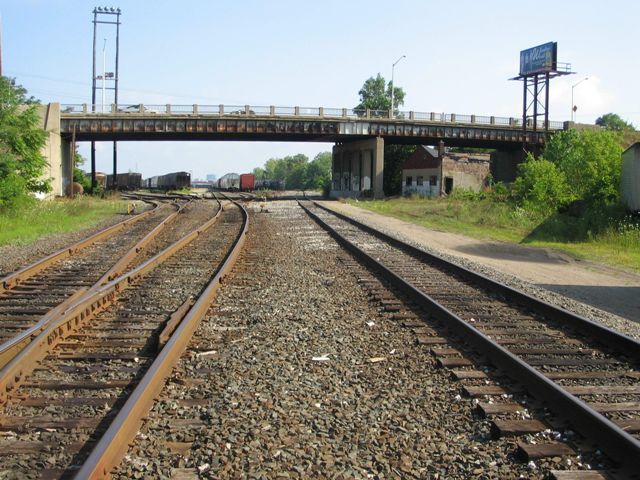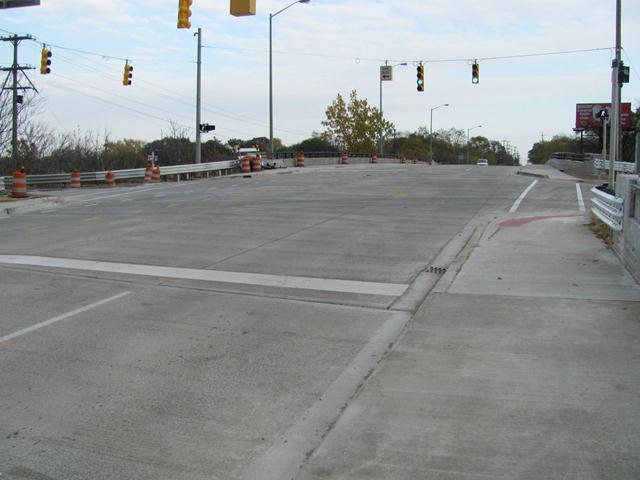We Recommend:
Bach Steel - Experts at historic truss bridge restoration.
BridgeHunter.com Phase 1 is released to the public! - Visit Now
Burton Street Railroad Overpass

Primary Photographer(s): Randy Mulder
Bridge Documented: August 12, 2010 and November 6, 2011
Grand Rapids: Kent County, Michigan: United States
1958 By Builder/Contractor: Darin and Armstrong, Inc of Detroit, Michigan and Engineer/Design: Michigan State Highway Department
Not Available or Not Applicable
120.0 Feet (36.6 Meters)
215.0 Feet (65.5 Meters)
44 Feet (13.41 Meters)
2 Main Span(s)
414278400502R01

View Information About HSR Ratings
Bridge Documentation
This bridge has been altered, resulting in a severe loss of historic integrity and significance!
View Archived National Bridge Inventory Report - Has Additional Details and Evaluation

Above: Photo of Troeger's conceptual drawing of the Burton Street Interchange (document housed in Michigan Archives)
About This Interchange
The Burton Street US-131 Interchange is a system of bridges and ramps which consists of a US-131 overpass, a railroad overpass, and associated entrance and exit ramps which connect with either Burton Street or adjacent Century Avenue. The entire collection of bridges and ramps should be considered historically and technologically significant as one of the more complete and complex engineering efforts found on the US-131 expressway. There are other interchanges along this section of freeway in Grand Rapids, but the other examples lack the historic integrity, and/or are less complex. The interchange currently is not evaluated as eligible for the National Register of Historic Places, but such a finding should be considered for this interchange, which now meets the 50 year requirement for eligibility consideration.
The original design of the interchange with US-131 originally included two methods for entering southbound US-131, one being a ramp leading south of Burton Street, the other being a ramp leading from Century Avenue. This ramp does not exist today. It is not known if this ramp was never built or if it was removed. It would not be something welcome on a modern freeway because it was somewhat redundant and would have increased the locations from which traffic merged onto US-131, which would be a safety concern.
Note: This particular page is dedicated to a discussion and documentation of the Railroad Overpass. The Burton Street Railroad Overpass, while part of the complete interchange system and a contributing structure in terms of the interchange's historic significance, has been given a separate page for clarity and organization. For documentation of the remainder of the interchange, including the ramps and the US-131 Bridge, visit the page for the Burton Street US-131 Bridge.
About The Burton Street Railroad Overpass
The Burton Street Railroad Overpass retains its original R4 railings, and unlike the US-131 bridge next to it, modern Armco guardrails have not been added to this bridge. This is probably because although the bridge would have been built as a State project, the bridge today is county-owned unlike the US-131 overpass which is MDOT owned. In addition to its contributions to the heritage value of the interchange, the railroad overpass is also individually noteworthy for several reasons. First, beams on the bridge are riveted built-up i-beams, which are far less common on stringer bridges than rolled beams. In addition, the bridge is a good example of a stringer that includes a pin and hanger joint design. The pin-and-hanger system was commonly used in the mid-20th Century in Michigan and other states. With a pin-and-hanger system, the ends of the stringers are not located over the piers like they would be in a traditional simple-spanning stringer bridge. One of the benefits of the system is that because the expansion joint is located over the pier, any water and salt that might drain through the joint does not land on the pier, so substructure deterioration rate is greatly reduced. Pin-and-hanger systems fell out of favor by the later part of the 20th Century because the pins were previously used to make it easier to do analysis for the design of the bridge. With today's computer technology however, this is no longer an issue. The pins also tend to require additional maintenance versus a standard stringer bridge. The Burton Street Railroad Overpass is no exception, since new stainless steel pins appear to have been installed on the bridge. From a historic significance standpoint however, pin-and-hanger systems are of interest because they are an unusual and relatively short-lived development in bridge design.
Documentation in the Troeger Collection
Michigan State Archives has a set of conceptual architectural drawings that were created during the formation of Michigan's Interstate Highway System. These are different from structural bridge and road plan sheets; they are instead artistic renderings that were created during the initial planning process to design the overall visual/aesthetic appearance of the highway system. The collection is called the Troeger Collection after Philip Troeger who created them for the Michigan State Highway Department.
Some of the Troeger drawings are not specific to a particular location or bridge and are instead generalized concepts, such as what a curved t-beam bridge should look like in depressed (cut) sections of freeway, or what the architectural detailing on bridge abutments should look like. Other sheets are bridge specific. Just by chance, the Burton Street interchange and overpasses are among the specific drawings.
Photos of the Troeger drawing for the Burton Street Interchange are available in the photo gallery.
This bridge is tagged with the following special condition(s): Unorganized Photos
![]()
Photo Galleries and Videos: Burton Street Railroad Overpass
Bridge Photo-Documentation
Original / Full Size PhotosA collection of overview and detail photos. This gallery offers photos in the highest available resolution and file size in a touch-friendly popup viewer.
Alternatively, Browse Without Using Viewer
![]()
Bridge Photo-Documentation
Mobile Optimized PhotosA collection of overview and detail photos. This gallery features data-friendly, fast-loading photos in a touch-friendly popup viewer.
Alternatively, Browse Without Using Viewer
![]()
Additional Unorganized Photos After Alteration
Original / Full Size PhotosA supplemental collection of photos that are from additional visit(s) to the bridge and have not been organized or captioned. This gallery offers photos in the highest available resolution and file size in a touch-friendly popup viewer.
Alternatively, Browse Without Using Viewer
![]()
Additional Unorganized Photos After Alteration
Mobile Optimized PhotosA supplemental collection of photos that are from additional visit(s) to the bridge and have not been organized or captioned. This gallery features data-friendly, fast-loading photos in a touch-friendly popup viewer.
Alternatively, Browse Without Using Viewer
![]()
Maps and Links: Burton Street Railroad Overpass
Coordinates (Latitude, Longitude):
Search For Additional Bridge Listings:
Bridgehunter.com: View listed bridges within 0.5 miles (0.8 kilometers) of this bridge.
Bridgehunter.com: View listed bridges within 10 miles (16 kilometers) of this bridge.
Additional Maps:
Google Streetview (If Available)
GeoHack (Additional Links and Coordinates)
Apple Maps (Via DuckDuckGo Search)
Apple Maps (Apple devices only)
Android: Open Location In Your Map or GPS App
Flickr Gallery (Find Nearby Photos)
Wikimedia Commons (Find Nearby Photos)
Directions Via Sygic For Android
Directions Via Sygic For iOS and Android Dolphin Browser
USGS National Map (United States Only)
Historical USGS Topo Maps (United States Only)
Historic Aerials (United States Only)
CalTopo Maps (United States Only)


